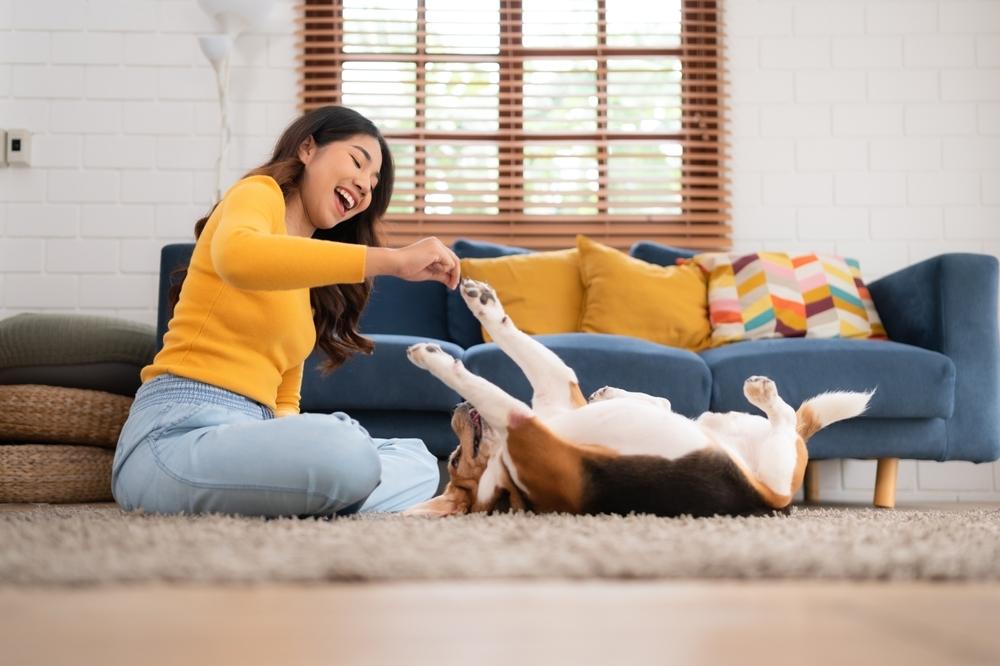

Spending time with a dog can be a great source of joy, but many pet parents find themselves wondering, "How do I know if my dog is happy too?" What are the signs of a well-adjusted, happy dog, and how can you boost your dog's overall contentment?
While every dog expresses joy a little differently, there are several common signals that can indicate happiness. From body language to behavior, these signs can provide insight into your dog's emotional well-being. Here's what to look for — plus tips to help ensure your furry friend stays as happy as they make you.
Signs of a Happy Dog
Not all dogs show happiness in the same way. For example, breed characteristics can influence how dogs express joy — for example, northern breeds like Siberian huskies often "talk" with happy howls, a trait that's rare in other dogs, like Chihuahuas. Chesapeake Bay retrievers are known for using growls as a form of communication, while Rottweilers may express pleasure during petting or play with low grumbles. If you're not sure of your dog's breed, you can obtain a dog DNA test to get insights into what types of behaviors you could expect from your pup.
It's important to understand both your dog's breed tendencies and their individual personality. Still, there are some nearly universal signs of happiness that most pet parents can easily recognize. Watch for these clear behavioral and physical cues that indicate a content, emotionally balanced dog.

Body Language
Relaxed body language is one of the most obvious indicators of a happy, content dog. Look for these signs:
A relaxed, loose posture
Soft eyes, sometimes squinting
A loose, wide, low-wagging tail (not stiff)
Hip wags, especially noticeable in dogs with cropped tails
A "doggy grin" — lips pulled back horizontally in a relaxed expression
Gentle, open-mouth panting
Ears held in a relaxed position, facing forward or softly to the side when greeting
Smooth fur (not bristled or with raised hackles)
Social Behavior
Social behavior that points to a happy, well-adjusted disposition includes:
Playful, bouncy movements
Play bows (front legs down, rear end up)
Showing interest in toys, like dropping one at your feet or initiating a game of keep-away
Seeking attention through pawing, barking, leaning in, resting their chin on you or soft mouthing (inhibited biting)
Snuggling or sitting on your lap
Sleeping near you
Licking your hands or face
Excited "spinning" when greeting you
Following you or other family members around the house
Bursts of "zoomies" (sudden, joyful racing around)
How to Support Your Dog's Emotional Well-Being
You can make a meaningful difference in your dog's happiness. The most important steps include supporting both their emotional and physical well-being, and that starts with understanding what dogs want and need out of life.
Regular Exercise
In the past, dogs with jobs, such as herding sheep or hunting game, naturally expended energy as part of their daily routine. Today's house dogs, however, may not get the same level of activity, especially if their main "job" is keeping you company or curling up on your lap. But even companion dogs benefit from regular exercise.
Physical activity can help dogs maintain a healthy weight, reduces stress, and may contribute to a longer, healthier life. It also encourages them to channel their energy into positive play (rather than troublesome behavior).
The right amount and type of exercise depends on the individual dog's breed, age and overall health. High-energy dogs and canine athletes may thrive on running or swimming laps (just be sure to rinse off any chlorinated water afterward!). Puppies need gentler exercise while their bones and joints are still developing. Overweight dogs and aging pups with stiff joints do best with short, slow walks to avoid injury while still staying active. For personalized advice, check with your veterinarian to find the best exercise routine for your dog's needs.

Mental Stimulation
Even the happiest dogs get bored from time to time. You can satisfy your pup's need for mental stimulation with a variety of enrichment toys and games. Obedience and command training not only provide valuable mental exercise but also strengthen the bond you share.
Older dogs or those with health challenges can still join the fun with low-impact activities like scent games, where they sniff out hidden treats or toys. Instead of feeding your dog from the same bowl each day, try turning mealtime into a fun challenge with puzzle feeders. Dogs are generally happier and more relaxed when they have something constructive to do, like chewing on approved outlets (e.g., dog toys) instead of furniture or your kid's toys.
Balanced Nutrition
"How do I know if my dog is happy," you ask? Wags and woofs of joy at mealtime can be a clue. For many dogs — especially food-motivated breeds like beagles and Labrador retrievers — mealtime tops the list for switching on happy behavior.
Of course, we all know that some dogs have questionable taste when it comes to what they eat (multi-species pet parents are strategic about litter box placement for a reason). So while good nutrition starts with what's in the bowl, it only works if your dog actually likes and eats the food. Consult your vet for the best nutritional plan for your dog. They can help you choose a complete and balanced formula based on your pup's age, size, activity level and any specific health or breed-related needs.
Quality Bonding Time
Use every moment with your dog as a chance to strengthen the bond you share. This is easy to do when you focus on giving your dog what they truly enjoy.
For some pups, that means tasty treats (in moderation—we recommend keeping treats to less than 10% of your dog's calorie intake). For others, your attention is the highest reward, whether it's through petting, playtime or training sessions. When dogs learn they can rely on you to meet their needs, it builds a sense of trust that's essential to their emotional well-being.
Dogs adopted later in life, especially from shelters, may need more time to feel safe and show relaxed, happy behavior. But once they realize they can count on you, these dogs are often capable of forming incredibly deep bonds.
Helping Your Dog Wind Down After Play
Some dogs may get so excited during exercise, energetic play or trips to fun new places that they have trouble settling down. While bursts of enthusiasm are among the signs of a happy dog, overly extreme or prolonged excitement can lead to overstimulation. So, build relaxation into your play routine to help your dog wind down.
A simple strategy is teaching a cue like "go to mat" or "go to crate" after playtime. For example, offer them a treat-loaded licky mat. Licking has a naturally calming effect on dogs, and they can't jump, bark or race around while they're focused on it. Incorporating crate time into your routine can also help your dog learn to recognize when it's time to chill and recharge after all the excitement.
Happiness Is a Content Dog
So, the next time you wonder, "How do I know if my dog is happy?" — trust your gut. Your dog has unique habits, quirks and behaviors that make them who they are, and as their person, you're often the best judge of their emotional state. All dog lovers want their pets to feel happy, and by making small, incremental changes to your daily routine, you can boost your dog's emotional and physical well-being and your own. After all, you and your dog are chosen family, destined to share a powerful bond meant to be celebrated and nurtured throughout your lives together.






















